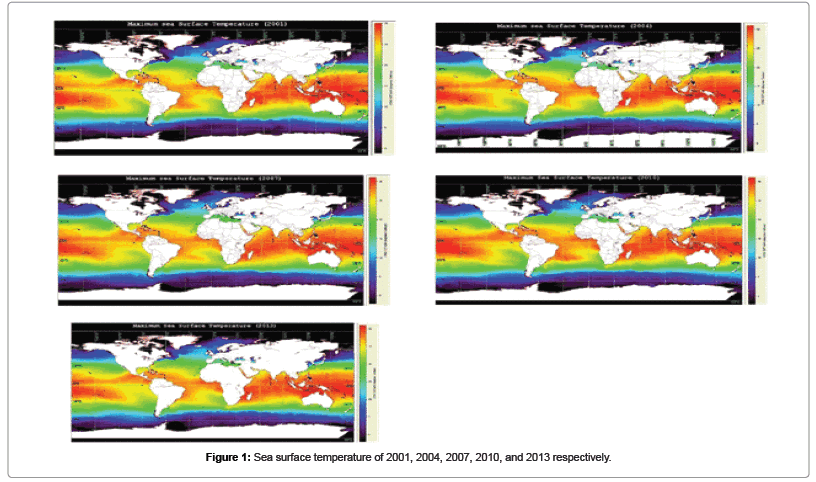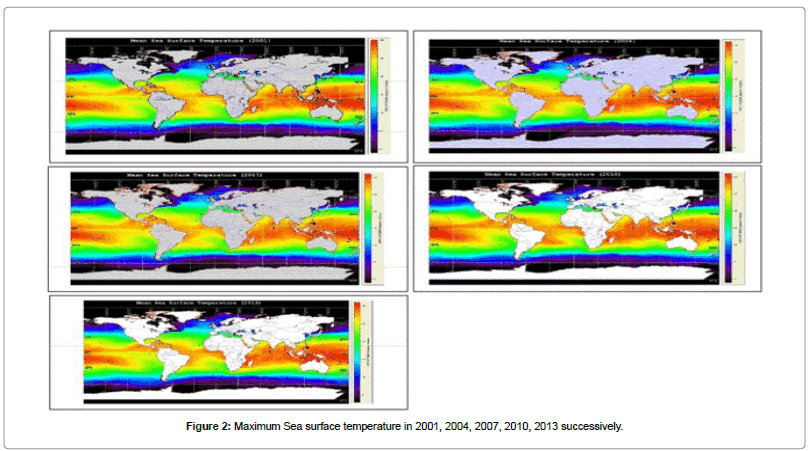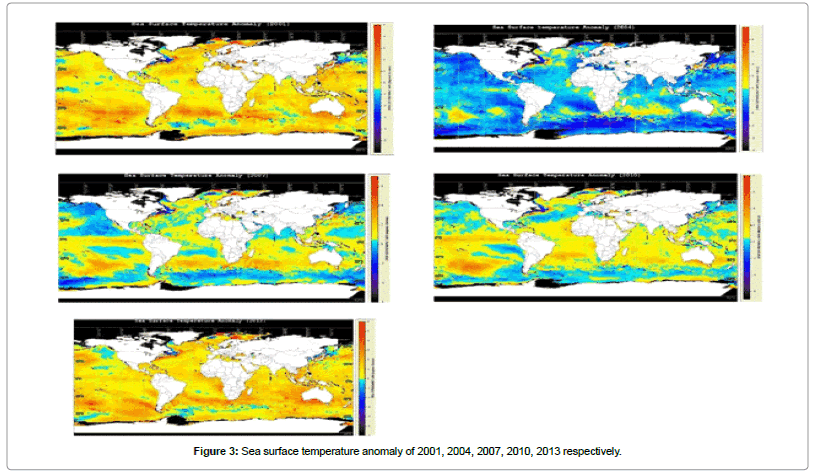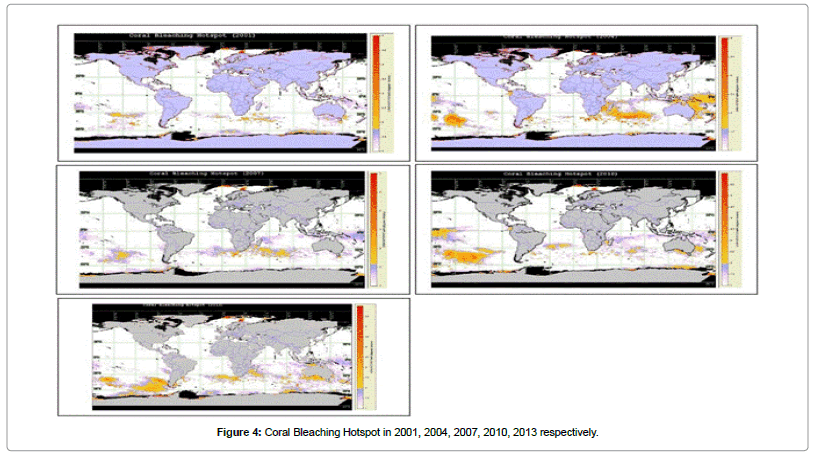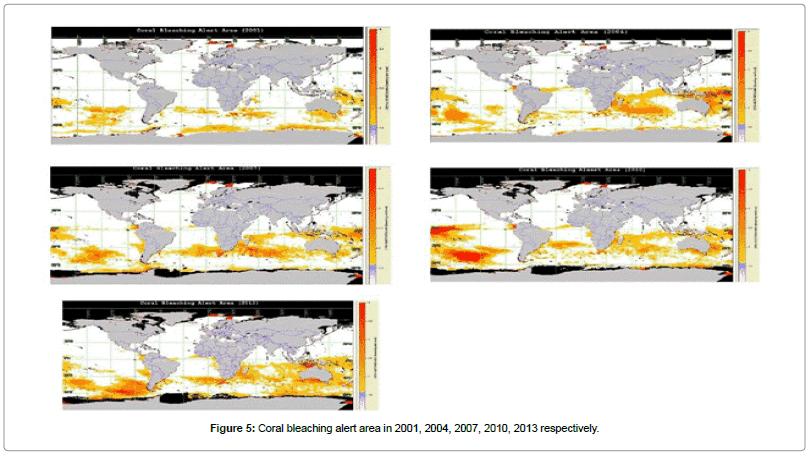Climate Change and Sea Surface Temperature: Modelling the Effects on Coral Bleaching
Received: 08-Sep-2014 / Accepted Date: 01-Nov-2014 / Published Date: 10-Nov-2014 DOI: 10.4172/2157-7617.1000235
Abstract
Presently climate change is a serious problem on corals and their associated ecosystems that also affects the national and international income. The Present study emphasizes the impact of sea surface temperature on coral living, coral bleaching, coral growth and modelling for influential high temperature on corals as a significant biodiversity of tropical regions. Coral bleaching information, data of Sea Surface Temperature (SST), and coast watch utility software collected from the National Oceanic and Atmospheric Administration (NOAA) is an important way of monitoring and modelling of coral responses to SST. These data represent that the higher range of sea surface temperature and anomaly is responsible for the greater change of the coral bleaching area and hotspot. Within the narrow sea surface temperature change coral can respond significantly. This model finds southern pacific is most vulnerable and attractive sites for coral bleaching. Eastern tropical Pacific and Caribbean coral has been affected by El Nino and the anomaly of sea surface temperature. We need to continue to develop the models for protecting the coral reefs to present natural and anthropogenic climate change induced sea surface temperature causing the coral bleaching events.
Keywords: Coral bleaching; Hotspot; Climate change; Biodiversity; Coral reef crisis
8462Introduction
The coral reef is a rich and predominant oceanic ecosystem of the tropics of Cancer and Capricorn where one third of total marine fish species, also thousands of other species present. These ecosystems also provide 6 million tons of fish in a year and have a greater significance for the generation of national and international income [1]. This is not only significant but also helps for the income of local community and their nutritional sustenance [2]. But now, these significant biodiversity is threatened due to increasing present climate change related events [3]. So these impacts now become one of the most serious problems with the Oceanic ecosystem as well as coral reefs. These corals are significantly bleached due to Climate change related increasing mean and anomaly of Sea Surface Temperatures (SSTs). Here, Coral bleaching indicates the general whitening of coral colonies that generalized the responses to climate related unfavorable global environmental conditions such as high sea surface temperature [4-6], anthropogenic influences [7], such as pollution, industrial waste, overfishing and mining [8], salinity disturbances [9] and other conditions also [10,11]. Climate induced ENSO events also resulted to mass coral bleaching that approximately destructed 16% of the total world’s coral community [12]. Since 1979, the intensity, number, and scale of coral bleaching incidents have grown in a devastating way and the trend also has been interred connected with present climate change related events [6]. These coral bleaching or coral mortality arrives a significant deterioration for cumulative burdening of water temperature [13]. In 1998, coral mortality occurred across most of the western part of Indian Ocean at an unprecedented scale [14] that altered significantly, the services and goods of this region [15] as well as all over the Indian Ocean [16]. These phenomena also occurred in a localized way for major storm events, tidal exposure, sedimentation and thermal shock [10].
The sea surface temperature increases with the predicted global air temperature arrived since 1.8-4.0°C [17]. The normal growth of coral depends on 29-31°C usual summer temperature in the tropics if coral can endure short term temperature raises up to 34°C but when these warming occur in a long term warming of SSTs is about 32-33°C cause to start to expel their zooxanthellae that means coral lose their tissue due to thermal stress [18]. So the communities of coral reef are passing very smartly from healthy condition to marginal status, at last dead. But recent coral bleaching occurred due to human induced sea level rise [19]. Coral bleaching is arrived potential condition widely when inshore monthly sea surface temperature exceeds 30-34°C [19].
In present view about “Coral reef crisis” [12], we emphasize potential sea surface temperature in the last 10 years that contributed by present significant human impacts [20,21]. The present study explores the relationship between temporal change of climate induced elevated sea surface temperature and global coral bleaching events.
The warm waters centered on the northern Antilles near the Virgin Islands and Puerto Rico expanded southward. Comparison of satellite data from the previous 20 years confirmed that thermal stress from the 2005 event was greater than the previous 20 years combined. The Satellite Bleaching Alert (SBA) system is an automated alert system that monitors thermal stress conducive to coral bleaching via the Hot Spot products. The SBA was developed as a tool for coral reef managers, scientists, and other interested people. Currently, the alerts are available for 24 coral reefs around the world.
Database and Methodology
Data used
The present study, primarily based on the collecting data of SST, anomaly of SST, coral bleaching alerted area and Coral bleaching hotspot. All the data has been collected from National Oceanic and Atmospheric Administration (NOAA)-14 from 2001 to 2014. NOAA- 14 primarily used AVHRR sensor for the collection of all ocean data. After collecting these data were processed by using coast watch data analysis tool and software. Editing and formatting of the data of mean sea surface temperature and coral bleaching is usually based on the data layer of NOAA. Coral Reef Early Warning System software also used for producing the coral bleaching alert area and coral bleaching hotspot.
Analytical tool
For the representation of their relationship, gridded files of sea surface temperature and coral bleaching area were imported in Environmental Systems Research Institute’s (ESRI) Arc Info software. Guinotte, [22] explains in more detail the methods of spatial analysis, mapping, and visual techniques in global marine environments.
Threshold identification
The effects of present increasing sea surface temperature on coral reefs were identified on the basis temporal change. The increasing hotspot area determined by the increasing sea surface temperature because of the coral’s higher response abilities. Kinsman [23] describes the critical limits of coral growth are signing up to 39.5°C but significant departures of temperature (sea surface temperature anomaly) are most significant.
The Role of SST on Coral Growth
Several studies analyze the importance of air temperature and growth of Coral colonies, but present studies examined the relation between sea surface temperature and growth of coral reefs. The relation undertakes the period from 2001 to 2014 which shows the negative relation between them. The calcification rate and growth rate also related to these factors and also extend the incoming solar radiation and temperature [24,25]. However, in the case of juvenile corals, a cooler year represents algometric growth and warmer years promote the isometric growth of corals [26,27]. The skeletal density also declined in a small scale due to sea surface temperature and other environmental parameter [28]. The fluctuations of sea surface temperature make them for the persistence of increasing hostile environment [29].
Coral growth rates also depend on the mean seasonal temperature. Inter decadal and inter seasonal changes in the coral growth rate interlinked with the minimum air temperature in the winter season. These temperatures affects the convenient changes of sea surface temperature, but here also responsible some other meteorological and oceanographic variables [30] also. Cold, dry air may be responsible for stressing corals and reducing their winter growth rate. This effect has been found in the flower gardens that is the cause of declining coral growth.
Results
Modeling the effects of high sea surface temperature on corals
The frequency of coral bleaching depends upon the present sea mean sea surface temperature and anomaly of SST and maximum SST (Figures 1 and 2). This Mean sea surface temperature gradually increases due to present greenhouse emissions. The future coral bleaching may be estimated by the projecting sea surface temperature from four different general Circulation models of IPCC (Intergovernmental panel for climate change) the sea surface temperature projections were used to find out the thermal thresholds of corals by using the Integrated Global Ocean Services System (IGOSS). All the datasets collected from the Joint world and Scientific Meteorological Organization (WMO), United Nations Educational, Scientific and Cultural Organization (UNESCO), Joint Intergovernmental Oceanographic commissions (JCOMM), Marine Meteorology and Technical Commission for Oceanography, also from Internet reports and literature. The fluctuations of sea surface temperature (Figure 3) make them for the persistence of increasing hostile environment Available these data indicate that frequency of bleaching events rises rapidly where the higher rate has been found in the Caribbean, Southeast Asia, and Australian Great Barrier Reef and the lowest rate found in the only Central Pacific (Figure 4). Bleaching events occurred due to the changes of sea surface temperature rather than by El Nino events [31] Coral mortality of the Indian Ocean has been found in a repeated way [32]. Increasing SST at 33 sites was blended into previous SST of the Indian Ocean. The satellite oriented coral bleaching and alerts [33] area significantly predicted by using the anomaly of sea surface temperature (Figure 3) [34]. The products mainly collected by Advanced Very High Resolution Radiometer (AVHRR) and the NOAA polar orbiting satellites (primarily SST) on nighttime.
Average (30 days) maximum daily temperature might be explaining the variability of the time dependent coral growth [2]. High temperature water has been suggested that the increasing rate of locally unrespectable mass bleaching events [35]. The modeling of James and Crabbe [1] suggests that coral, mostly responded by the rate of temperature change as well as anomaly of temperature also. The present study analyzes that coral lives close to their maximum temperature threshold at the time of warmest summer months that may stress to coral bleaching. The study has been found most of the bleaching events occur in the tropical Indian Ocean and tropical Pacific and but not significantly in the Atlantic oceans. The coral bleaching events also affected to Acropora elizabethensis (Middleton reef) and Acropora tortuosa (Elizabeth reef) in south eastern Australia, Rawaki Island, Cook Island and Phoenix Islands (Protected Area), Orona atoll, Manihiki Atoll in the south western Pacific region. Alberta atoll and Glorioso islands in South Western Indian ocean Coral bleaching is mostly varies during the last decade. In the Present view of coral bleaching southern pacific is most vulnerable site and most attractive bleaching events occur in Southern Pacific as well as Tropical Pacific region. Most of eastern tropical Pacific and Caribbean coral has been affected by El Nino [36] and the anomaly of sea surface temperature. This Unprecedented nature of coral bleaching events in the last decade has led some to cause of Global Warming [37].
Most evidence indicates that elevated temperature is the cause of mass bleaching events. Sixty major episodes of coral bleaching have occurred between 1979 and 1990, with the associated coral mortality affecting reefs in every part of the world. Correlative field studies have pointed to warmer-than normal conditions as being responsible for triggering mass bleaching events. These studies show a tight association between warmer-than-normal conditions (at least 1°C higher than the summer maximum) and the incidence of coral bleaching.
Discussion
Sea surface temperature increases due to natural and man-made (indirect and direct) disturbances at various scales. Storm, typhoon is also responsible for these changing patterns that conveniently occur in Tropical Pacific Ocean, Indian Ocean as well as Andaman Sea [38]. South western part of the Pacific Ocean is the only place where most of Coral bleaching area increases due to Tsunami (2004, 26th December). Such results prove that the Tsunami activity also affects the Coral bleaching as well as coral mortality. But in Present time coral bleaching occurred at different time period due to increasing SST [19] that must be linked with present climate change. In last several years’ coral bleaching also affected by nutrients, Turbidity and high sedimentation loads [39]. These sedimentation rate responsible for the increase ocean temperature and temperature anomaly also. On a large spatial scale, live coral area gradually decreases in the southern Indian Ocean, Eastern Pacific Ocean & western Pacific Ocean. That’s why these regions have a lot of alert area (Figure 5) of coral bleaching. In addition, internal wave action and offshore current play the fluctuation of sea surface temperature. The amount of coral bleaching also depends upon Species diversity, bleaching susceptibility and relative fluctuation of ocean water. However, the live corals bleached in higher rate due to the affection of all factors all over the world’s oceans.
Conclusion
Climate processes and extreme weather events can influence the growth of reef colonies. The Coral growth highly influential and sensitive to narrow range of temperature, water PH, radiation, salinity, intensity, ocean currents, turbidity and sedimentation rate. Present day all empirical models signify that the growth of coral influenced by the small changes in temperature and the rates of temperature change. We need to continue developing various models for knowing non steady-states (such as, climate change & global warming) effects on the morphology of coral reef. With respect to, ecosystem based management option [40,41], it might be essential to emphasize over fishing, coastal pollution, destructive fishing and sedimentation rate.
Acknowledgements
The authors wish the first and foremost, thanks to my research supervisor Dr. Krishnendra Meena and my first year course work professors, including Prof. Rajesh Rajagopalan, Dr. Madhan Mohan, Dr. Manish Dabhade, Dr. Shivaji Kumar, Dr. Dipendra Nath Das and Prof. Milap Chand Sharma and at Jawaharlal Nehru University (JNU). I am also thankful to National Oceanic and Atmospheric Administration (NOAA) for providing the significant software and data. Also extend huge and warm thanks to some of my friends Biswajit Mondal, Sumantra Sarathi Biswas and Raghunath Pal and seniors Prasenjit Acharya and Avijit Mistri at JNU who always support different kinds of technical and supportive assistance for the research work.
References
- James M, Crabbe MJ (2008) Climate change, global warming and coral reefs: Modelling. ComputBiolChem 32: 311-314.
- Crabbe MJ, Walker EL, Stephenson DB (2008) The impact of weather and climate extremes on coral growth. In: Diaz, H., Murnane, R. (Eds.). In Diaz H, Murnane R (edn), ClimateExtremes and Society 165–188. Cambridge, UK,: Cambridge University Press.
- Hughes TP, Baird AH, Bellwood DR, Card M, Connolly SR, et al. (2003) Climate change, human impacts, and the resilience of coral reefs. Sci 301: 929-933.
- Glynn PW (1993) Coral reef bleaching: ecological perspectives. Coral reefs 12: 1-17.
- Brown B (1997) Coral bleaching: A Review of causes and consequences. Coral Reefs 16: 129-138.
- Hoegh-Guldberg O (1999) Climate change, coral bleaching and the future of the world’s coral reefs. Marine Freshwater Res 50: 839-866.
- Nystrom M, Folke C, Moberg F (2000) Coral reef disturbance and resilience in auman-dominated environment. Trends EcolEvol 15: 413-417.
- Mumby PJ, Hastings A, Edwards HJ (2007) Thresholds and the resilience of Caribbean coral reefs. Nature 450: 98-101.
- Goreau TF (1964) Mass expulsion of zooxanthellae from Jamaican reef communities after Hurricane Flora. Sci 145: 383-386.
- Glynn PW (1993) Monsoonal upwelling and episodic Acanthaster predation as probable controls of coral reef distribution and community structure in Oman, Indian Ocean. Atoll Res Bull 379: 1-66.
- Glynn PW (1996) Coral reef bleaching: facts, hypotheses and implications. Glob Change Biol 2: 495-509.
- Wilkinson C (2002) Status of Coral Reefs of the World: 2002. Townsville: Australian Institute of Marine Science, Townsville, Australia.
- Wilkinson C (2008) Status of Coral Reefs of the World: 2008. Townsville: Global Coral Reef Monitoring Network & Reef and Rainforest Research Centre, Townsville, Australia 296.
- Graham NA, Wilson SK, Jennings S, Polunin NV, Bijoux JP, et al. (2006). Dynamic fragility of oceanic coral reef ecosystems. PNAS 103: 8425-8429.
- Pratchett MS, Munday PL, Wilson SK, Graham NA, Cinner JE, et al. (2008) Effects of climate-induced coral bleaching on coral-reef fishes-ecological and economic consequences. Annu Rev Oceanogr Mar Biol 46: 251–296.
- Obura DO (2005) Resilience and climate change: lessons from coral reefs and bleaching in Western Indian Ocean. Estuar Coast Shelf Sci 63: 353-372.
- Parry ML, Canziani OF, Palutikof JP, Van der Linden PJ, Hanson CE (2007) ClimateChange 2007: Impacts, Adaptation, and Vulnerability. UK: Contribution of Working Group II tothe Fourth Assessment Report of the Intergovernmental Panel on Climate Change, Cambridge University Press, Cambridge.
- Szmant AM, Gassman NJ (1990) The effects of prolonged ‘bleaching’ on the tissue biomass and reproduction of the reef coral Montastraeaannularis. Coral Reefs 8: 217-224.
- Phongsuwan N, Chansang H (2012) Repeated coral bleaching in the Andaman Sea, Thailand, during the last two decades. Phuket Mar Biol Cent Res Bull 71: 19-41.
- Sheppard C (1995) The shifting baseline syndrome. Mar Pollut Bull 30: 766-767.
- Pandolfi JM, Bradbury RH, Sala E, Hughes TP, Bjorndal KA, et al. (2003) Global trajectories of the long-term decline of coral reef ecosystems. Sci 301: 955-958.
- Guinotte JM (1999) A model for predicting coral reef habitat in the tropical western Atlanticand Eastern Pacific. Manhattan, Kanhas: Kansas State University.
- Kinsman DJJ (1964) Reef coral tolerance of high temperature and salinities. Nature, 202: 1280-1282.
- Lough JM, Barnes DJ (2000) Environmental controls on growth of the massive coral Porites. J Exp Mar Biol 245: 225-243.
- Nie B, Chen T, Liang M, Wang Y, Zhong J, et al. (1997) Relationship between coral growth rate and sea surface temperature in the northern part of the South China Sea during the past 100 years. Sci China Series D 40: 173-182.
- Edmunds PJ (2006) Temperature-mediated transitions between isometry and allometry in a collonialmoduler invertebrate. ProcBiolSci 275: 2275-2281.
- Edmunds PJ (2008) The effects of temperature on the growth of juvenile scleractinian corals. MarineBiol 154: 153-162.
- Cooper TF, Ath G, Fabricius KE, Lough JM (2008) Declining coral calcification in massive Porites in two nearshore regions of the northern Great Barrier Reef. Global ChangeBiol 14: 529-538.
- McClanahan TR, Ateweberhan M, Muhando C, Maina J, Mohammed SM (2007) Effects of climate and seawater temperature variation on coral bleaching and mortality. EcologicalMonographs, McClanahan TR, Ateweberhan M, Muhando C, Maina J, Mohammed SM 74: 503-525.
- Slowey NC, Crowley TJ (1995) Interdecadal variability of northern hemisphere circulation recorded by Gulf of Mexico corals. Geophys Res Lett22: 2345-2348.
- Jones RJ (2008) Coral bleaching, bleaching-induced mortality, and the adaptive significance of the bleaching response. Marine Biol 154: 65-80.
- Sheppard CR (2003) Predicted recurrences of mass coral mortality in the Indian Ocean. Nature 425: 294-297.
- NOAA Extended Reconstructed Sea Surface Temperature (SST) V3b (2008). NOAA. Earth System Research Laboratory.
- Liu G, Strong AE, Skirving WJ, Arzayus LF (2006) Overview of NOAA coral reef watch program’s near-real-time satellite global coral bleaching monitoring activities. Okinawa: In: Proceedings of the 10th International Coral Reef Symposium.
- Goreau T (1992) Bleaching and reef community change in Jamaica – 1951–1991. Amer Zool 32: 683-695.
- Goreau TJ, Hayes RL (1994) Coral bleaching and ocean “hot spotsâ€. Ambio23: 176-180.
- Gleeson MW, Strong AE (1995) Applying multi-channel Sea Surface temperature to Coral reef bleaching. Adv Space Res 16: 151-154.
- Phongsuwan N (1991) Recolonization of a coral reef damaged by a storm on Phuket Island, Thailand. Phuket Mar Biol Cent Res Bull 56: 73-81.
- Reopanichkul P, Carter RW, Worachananant S, Crossland CJ (2010) Waste- water discharge degrades coastal waters and reef communities in southern Thailand. Mar Environ Res 69: 287-296.
- Bouma J, Bulte E, Van Soest D (2008) Trust and cooperation: Social capital and community resource management. J Environ Econ Manage 56: 155-166.
- Crabbe MJ (2009) Identifying management needs for sustainable coral-reef ecosystems. Sustainability:Sci Practice Policy 5: 42-47.
Citation: Pramanik MK (2014) Climate Change and Sea Surface Temperature: Modelling the Effects on Coral Bleaching. J Earth Sci Clim Change 5: 235. DOI: 10.4172/2157-7617.1000235
Copyright: ©2014 Pramanik MK. This is an open-access article distributed under the terms of the Creative Commons Attribution License, which permits unrestricted use, distribution, and reproduction in any medium, provided the original author and source are credited.
Select your language of interest to view the total content in your interested language
Share This Article
Recommended Journals
Open Access Journals
Article Tools
Article Usage
- Total views: 17907
- [From(publication date): 11-2014 - Sep 02, 2025]
- Breakdown by view type
- HTML page views: 12966
- PDF downloads: 4941

